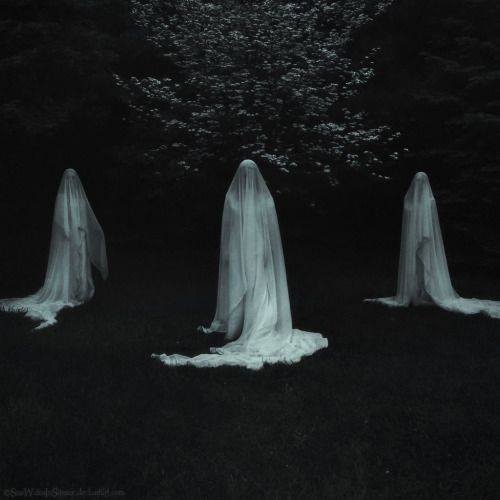#land spirits
Text
I am TELLING YOU if you have spent months, years, around the same trees, land, etc., they WILL recognize you and reach out to you or not mind if you reach out to them. You don’t need to know anything about them.
A tree in the forest behind my parents house I’ve never spoken to before reached out - I never would’ve expected it. I don’t know what kind of tree it is. But of course this tree knows me. This tree has known me since I was six.
Trust me. This land knows you. These plants know you. They want to speak with you.
#personal#witchblr#witchcraft#witchy#magick#nature#spirituality#witchy vibes#green witch#green witchery#green witchcraft#spiritual growth#spirit work#spirit witch#animism#nature spirits#tree spirits#tree spirit#land spirits#land spirit#spirit communication#baby witch#baby witch tips
1K notes
·
View notes
Text
my tip to befriending nature spirits is to just like Go There and be around them. maybe sprinkle a few native seeds for the birds, give a squirrel a little pile of nuts, clean up a bit, sing a little, etc. they'll get used to you being around and be like "oh!!! the human who sings to us is back!!" its literally that easy. just do nice things and spend time with them, they'll warm up to you.
1K notes
·
View notes
Note
hi lailoken, what would you recommend for a beginner hoping to contact local spirits? I've tried some things but had no results, so i thought I would try asking you :) my apologies if you have been asked this before, i couldn't find anything on your blog!
I may have answered something like this before, but I'm honestly not sure, so I'll do my best to just answer it here. This will look a little different for everyone, but this is what I can say based on my own experiences:
Spend a lot of time in nature.
This is really important. In my experience, it does quite a lot to teach you about local spirits and how one might best approach them. Aside from natural spaces, very old and historically meaningful locales can also be useful to spend time in, though, this is particularly useful when such locals are desolate.
Look into the native mythology and culture of your region.
This can look very different depending on where you are, but I believe it to be vital if you live in a colonized area. While I, in no way, encourage appropriating the beliefs or practices of a colonized area's local indigenous communities, I believe that attempting to make meaningful contact with regional spirits is lacking and disingenuous if it doesn't acknowledge the oldest and most traditional accounts of those spirits.
Learn about the flora and fauna of your region.
This is closely aligned with my first point about spending time in nature, but while that first point has more to do with developing a personal relationship to the land and learning intuitively from it, this point has more to do with actually learning about the biology and synergy of the lifeforms that make up that nature. I partially think this is important for the sake of respecting and understanding the land in a basic, but I also think that a lot of spiritual wisdom can be unintentionally gleaned from a scientific appreciation of nature.
Learn about the history of your region.
This may not always feel like the most thrilling or rewarding aspect of this work, but I think it is also quite important. In the same way that learning about flora and fauna teaches you about the land, learning about the history of a given region can do a lot to inform both your appreciation for a place, as well as highlighting or confirming any personal gnosis you may be sorting through.
Work on dream recall and interpretation.
I believe this to be of major importance for every form of spirit-work. Without a grasp of oneiric work, I think most spirit-work will stagnate, at best, and struggle with getting off the ground to begin with, at worst.
Pray earnestly and often, even if it doesn't necessarily feel like anything is "happening."
This is pretty simple and self-explanatory, but I think it can make a world of difference. Consistent prayer can do a lot to help with building faith, patience, and even intuition.
116 notes
·
View notes
Text
Witches in Britain fall on either side of the divide and the divide runs along the border of Wales and the Highland line of Scotland. So on one side the Scottish Highlands and islands and Wales, and the other side is lowland Scotland and England. And they are actually two different cultures when it comes to witch hunting - they are two different cultures in other ways as well. What they have in common, although with great variations between them, is that they are Celtic societies. In Celtic speaking societies there doesn't seem to be a disposition to hunt witches, instead, misfortune tends to be blamed on land spirits - faeries.
Professor Ronald Hutton puts forward his theory for why, historically, there was a lack of witch hunts in the Celtic speaking societies of Britain, in comparison to the non-Celtic parts i.e England.
Transcription from the podcast series 'Witch' - Episode 2 - Natural Magic. Full series can be found here
#witches#pagan#celtic#wales#cymru#scotland#highlands#witch trials#witchy#land spirits#faeries#celt#professor ronald hutton#ronald hutton#witch hunt#celtic nations#history#culture#emeraldgazette
76 notes
·
View notes
Text
Personal & collected tips regarding the maintenance of a harmonious relationship with the landvættir (land spirits)

“It is laid down in the first clause of the pagan law of Iceland, introduced about AD 930, that no one may approach the country in ships furnished with gaping heads and yawning snouts, i.e. dragon-heads. If they had them they must remove them before they came in sight of land, for otherwise the landvaættir would take fright.” - Myth and Religion of the North: The Religion of Ancient Scandinavia (1964)

Quick note: if you follow the norse pagan path, Landdísir, Jötnar/Trolls/Thurses, Álfar, and even ancestors could be considered land spirits, depending on your personal experience and interpretation of historical sources.
“They do not typically speak in English words, or words of any human language. They speak in wind, in the crackle of fire, in images and concepts and intense emotions.” - Earl S. Wynn.
In my experience, when compared to communication with fair folk, land spirit work is usually a lot more one-sided. Despite this, it’s important to keep in mind that spirits are conscious: they are individuals just like you and I, so we should treat them with love and respect, exactly in the way we would want to be treated. When it comes to landvættir, don’t expect a great deal of active communication, but rather watch out for little casual blessings that may start popping up once you start building a relationship with the land. By “land”, I mean both the land and the spirits that inhabit it, as they make a whole and are sustained by one another. The land you will work with is the area that you live in. Yes, even if it is a large city. Cities were all built upon age-old land, and this fact can be observed even in the most bustling and crowded ones. Is there a park you used to visit as a kid? Or a line of trees near your house? Small as they may seem, these places are the type to be inhabited by landvættir. Now, how do you start working with them?
“King Harald told a warlock to hie to Iceland in some altered shape, and to try what he could learn there to tell him: and he set out in the shape of a whale. And when he came near to the land he went to the west side of Iceland, north around the land, where he saw all the mountains and hills full of guardian-spirits, some great, some small.” - Heimskringla: The Chronicle of The Kings of Norway, “King Olaf Trygvason's Saga”, chapter 6.

The first step to landvættir work is actually excessively simple. It is to acknowledge the soul within natural elements. Look around yourself, when in nature, and notice which trees, stones, boulders or plants catch your eye.
The Order of Bards, Ovates and Druids suggests to take note of the following landmarks in order to get to know your own area: the highest place, the nearest body of water, the nearest area of natural beauty, the busiest open space where people congregate on a daily basis, the most abused or neglected site, the oldest sacred site under continuous use, the nearest place where the dead are commemorated or buried, the nearest natural food-producing ground, the place most frequented by wild (non-domestic) animals, the nearest major crossroads, and other significant sites that occur to you or that may be particular to your location e.g. marsh-land, heavy industry sites, etc.
If there is a certain spot you feel most drawn to, why note make it into a sort of land altar? By land altar, I mean a place where you can regularly go to rest and commune with nature. It isn’t necessary to set up a whole altar, and I would even advise against adorning it with excessive decorations, especially unnatural ones. As much as possible, try to avoid wrappings and plastics! However, you can mark the spot with things you pick up in the area: a pretty flower or leaf, a fallen tree branch, a handful of acorns, an usual-looking rock and such. It’s okay to put these on your land altar as long as they are from the area. Picking these sorts of things up and giving them back to nature is a means to show that not only do you observe the gifts of the land you live on, but that you also appreciate them. That you see their beauty and their value. By choosing a specific spot to make such offerings, you also give the landvættir a place where they can reach back to you, where you can hear their voices and feel their touch. If you are interested in working with a tree spirit, or choosing one as you land altar, I suggest taking a look at this previous post of mine where I detailed how to get started with such a relationship!
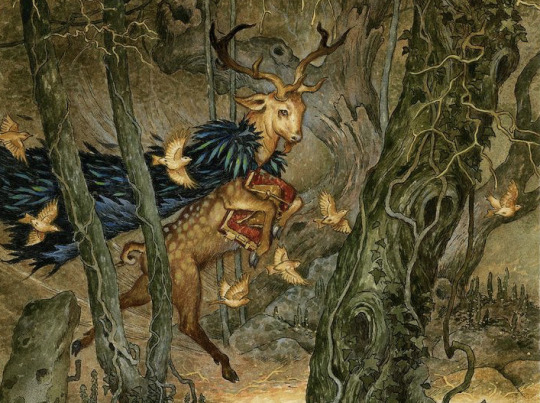
Disclaimer: if you keep getting a bad feeling about the place you’ve chosen for your land altar, I would definitely advise changing spots. It could mean a particular land spirit does not want to be disturbed, and it would be rude not to respect their wish.
Once you’ve chosen this space and once you feel truly settled with it, it’s a great idea to bless it from time to time. You can do so by blessing water and pouring it around and over that spot, or by singing a certain song, or chanting, etc. Simply naming what you see around you, stating the names of these natural elements, can be considered blessing, for you are acknowledging their souls. Through meditation, you may start hearing some spirits tell you the names they want to be called. Keep them in mind!
I would deem all of these “blessing” gestures offerings, though you could also offer the aforementionned leaves, flowers, rocks, acorns, as well pinecones, collected resin, earth, food you grew in your garden, etc. No matter the shape your offerings take, it is exceedingly important to be regular with them. I don’t mean you need to have a schedule (you could pretty much gift whatever, whenever), but you cannot expect for the spirits to appreciate your presence or give back to you if you have only spent time with them once or twice. Plus, you cannot truly get to know your local spirits if you don’t take the necessary time to get to know them!

Now, I’ve been using a woodland setting as my example, but it’s obvious the landvættir are completey different individuals depending on where you live. They are different in swamps, along beaches, high in the mountains, etc. It is possible to maintain a land altar no matter what your area looks like. After all, the most important part of land spirit work is to acknowledge and live in harmony with your local spirits— the guardians of your land. In fact, I find it a good idea to locate your land altar near a natural symbol of your nation/country/area! In order to do this in an even more personal way, I suggest looking into your ancestral practices! You may notice that previous generations gave back to the land in specific ways, which you could very well include in your own practice.
Once you’ve gone through all of these steps, keep your mind open so as to receive whatever messages or gifts the landvættir want to give in return. They might take a lot of time to answer, but stay patient. After all, their very existence and the protection they grant land is already a gift in an of itself. Sit at your land altar and open your senses. In my experience, landvættir can show their appreciation through a range of very discreet presents such as birdsong, a feeling of absolute peace and joy, a piece of knowledge, or even a new and unexpected flower that catches your eye and which you’ve never seen before. You never know what they might send you next, so best to stay aware of your surroundings when communing with nature. It has lots and lots to give, if you stand ready to receive!
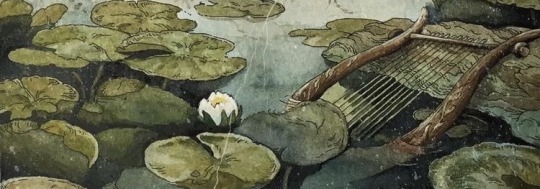
Artworks and pictures: Winter Foxes by Chuck Groenink, Yule Stag by Sebastian McKinnon, painting by Omar Rayyan II, illustration by David Wyatt, land altar photograph, illustration by Lily Seika Jones.
#spirit work#heathenry#spirits#land spirits#tree lore#tree spirits#paganism#norse paganism#witchcraft#deities#deity work#animism#spirituality#forests#polytheism#witchy tips
229 notes
·
View notes
Text
I cleaned up and reorganized my landvættir shrine, and I have to say, I'm pleased with how it looks. Hopefully the landvættir are as well!
34 notes
·
View notes
Text
metroponics
most people are metroponically grown
rootless, the root
of our exploitation
of self, of earth, of spirit.
befriend soil
and then tell me the ways
you will commit injustice.
#poetry#poem#prose poetry#prose#prose poem#poetic#writerscreed#spilled ink#flash poem#poet#savage words#poetryportal#13cupsofteareblog#spirituality#land spirits
15 notes
·
View notes
Text
They Made It!


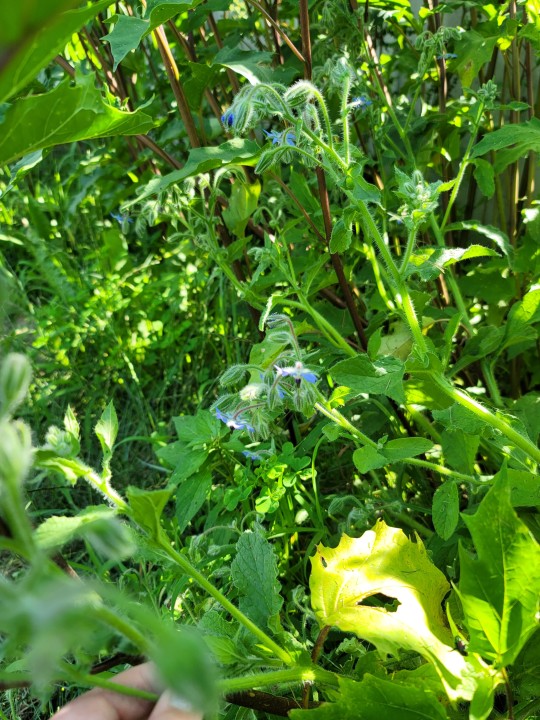
I thought my wildflower experiments were a total bomb but they came up. My dad kept not mowing them and they came up after the heavy rains we had a few weeks ago. Now they're in bloom!
Also thought an invasive weed had taken over my whole side yard garden - but I found some borage in there! One of my favorite gals!
So I'm exceedingly pumped!
19 notes
·
View notes
Text
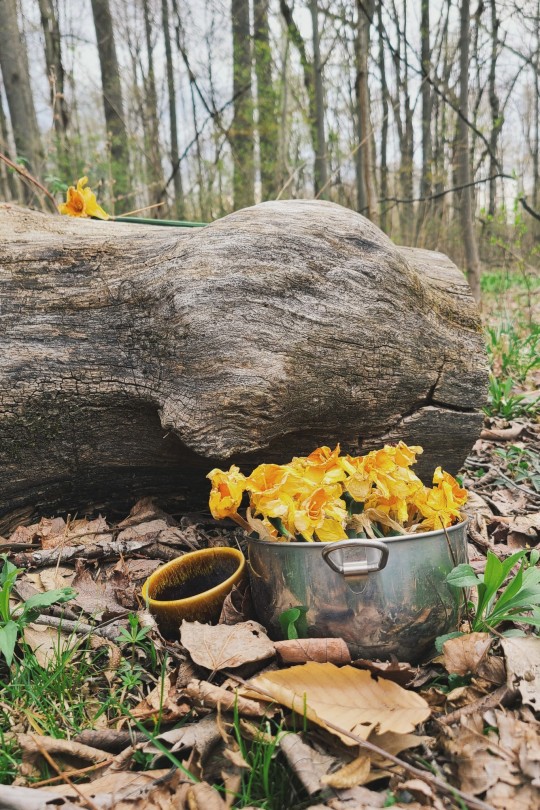
A quick offering to the Landvættir of pruned daffodils. I wanted to wrap some to hang in my office, but they are poisonous to cats so they were all gifted instead!
#norse pagan#norse paganism#witchcraft#landvaettir#land spirits#spirit work#nature spirits#nature#nature photography
42 notes
·
View notes
Text
The Less Mystical Side of Fairy Witching
The last couple of posts I’ve made about my work with the Fair Folk have been pretty woo, so I thought I’d share another anecdote that’s decidedly more… mundane.
It's spring now by most people's reckoning (though I personally tend to see the equinoxes as the midpoints of their respective seasons), and as I write this it certainly feels like it, too - 65 and sunny and breezy. Which means I now need to fulfill a promise I made last year to my local Fairy Queen.
When we moved to our current house at the very beginning of the pandemic (no joke, our closing was three days before the governor shut the state down), there was a flowering cherry tree in the front yard that was clearly on the wane. Some of the branches were dead and there was a hole in the trunk that revealed rotten wood inside. Still, that spring, it flowered. And again, in 2021. And again, in 2022. We trimmed away some of the dead branches, and tried to prune it gently each year, but when it failed to put out a full crown of leaves last spring, we got a notice from the HOA - dead trees weren't allowed, particularly not in front yards, and it would need to be cut down asap. I had hoped we'd be able to let the tree die gracefully over a winter, but despite the few leaves it did have, there was no convincing the HOA it was still “alive enough” so we conceded.
As I usually do when I have to make major changes to my yard, I explained what had transpired to both the land spirits and our local fae — and was met with disapproval. I understood — I didn't really like it, either — but caught between the two powers, I attempted to negotiate a fine price for the tree, instead. I was told I would need to replace the tree the following spring, before a year and a day had gone by, and that it would need to be a tree that bore both flowers and fruits, and should be in the Rose family, as wild roses are the symbol of my Local Queen.
So this week's fairy witching task was calling several local tree nurseries and garden centers to find one that has something like a crabapple or wild cherry or upright serviceberry, that will plant it for us, and has some kind of guarantee to replace the tree if it dies… that fits my somewhat small budget. And once I do, I'll need to schedule the tree to be planted before the beginning of June.
I think I’ve decided which nursery, I just want to go in to select the tree (likely a crabapple), and then I think they should be able to schedule the planting sometime before Bealtaine, which would be ideal! And then the lonesome stump in the front yard will have a friend, and hopefully the Fair Folk won’t blight my vegetable garden.
But yeah, word to the wise… these connections and agreements do have measurable effects on my personal mundane life as well. So keep that in mind, if you’re interested in doing this work.
38 notes
·
View notes
Text
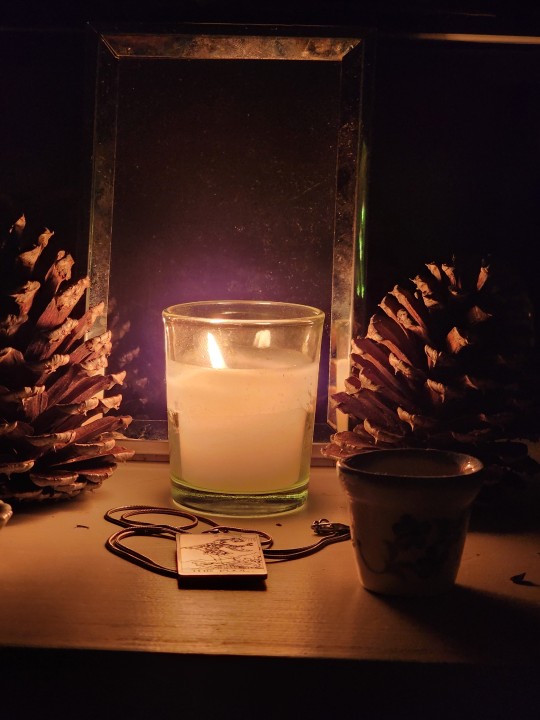
I had a talk with folks
#folk witch#witches of tumblr#folk mystic#witchcraft#ancestors#ancestor altar#ancestor veneration#land spirits#spirits of place
14 notes
·
View notes
Text
"Surrounded by the forest's trees, I am surrounded by the spirits of the forest. I sit here, on the needles and leaves, and spread my arms in greeting. Come to me, if you wish; I hope for your coming. I wait here for you, hoping to see you. And if you do not come, I will still leave these gifts for you, for my hands are not closed. My hands are open in generosity toward you, they are extended in friendship towards you."
A Book of Pagan Prayer by Ceisiwr Serith, pgs. 103-104
8 notes
·
View notes
Note
When working with an arboreal spirit (Old Man Willow, the Juniper Mistress, the Elder Mother) or really any spirit for that matter, how do you determine the gender of the spirit? Is it something directly communicated? Do you address them based on instinct about their gender or is it folklore from how they were addressed in the past that prompts it? Is this how the spirit communicates itself to you specifically? Meaning could another practitioner interact with the exact same spirit and perceive it as female, even though you experience it as male, and vice versa? I love reading your posts about tree spirits but they’ve prompted this curiosity.
In my experience, spirits do not experience gender in the way humans do. I answered a question about that here in more depth, but I essentially believe that numinous entities tend to "take on" gender presentation when interacting with humans, in the process of making themselves observable to us. I think this largely has to do with human beliefs and expectations creating a kind of "psychic impression" that affects the manifestation of a spirit. This doesn't mean a spirit will always present in a particular way, but I think that the longer a numinous Wight has been regarded and propitiated under a certain guise, the more defined and consistent that "psychic impression" becomes.
I think that using existing lore is a good rule of thumb where this sort of thing is involved—such as the lore of the Elder Mother or the Juniper Mistress—but aside from that, I mostly rely on dreams and intuitions. I often don't experience any sort of inclination about gender when working with spirits, one way or another, but when I do (such as with Old Man Willow or Lady Whitethorn,) it almost always comes out of my mouth before I've even had time to think about it, but then feels instinctively right and true.
#anonymous#ask#tree spirits#plant spirits#tutelary spirits#land spirits#spirits#spirit work#elder mother#juniper mistress#old man willow#lady whitethorn
34 notes
·
View notes
Text
The hardest part about being a Spirit Worker, for me, is meeting the spirits of places that are really rightfully fed up with humans and what they are doing to them. My tears and feelings of regret cannot undo the harm we've done to the land, but often it is the best offering I have. (along with cleaning up the trash, which is an always offering)
32 notes
·
View notes
Note
Hi! I saw your post on the alfar (and land spirits in the context of heathenry). I was wondering if you might know of or want to share some more facts specifically unique to the Alfar? I’m really interested in them because there’s been a lot of debate I’ve seen on where they differ from the Irish fair folk and where they are similar. When I first learned about norse mythology the book I read depicted them very similarly to Irish faeries. But now I’m wondering based on your last post if that book’s depiction was misleading? UPG is acceptable too! If you have any experiences with them.
Hi there! Thanks for coming to me with your question! It really is a nuanced and interesting topic, which is why I wanted to make a full post out of this. I've actually mean to post about álfar for a while, so I guess now’s my chance! However, the sources we have concerning them aren't many, which makes it quite difficult to describe them, or the way the were regarded in pre-christian germanic societies. What we can say for sure is that they are supernatural beings tightly linked to nature, and that the norse álfar are actually the oldest known elves. They could be nature spirits, or even gods! That last possibility is due to their being constantly called "Vanir" in at least one piece of norse poetry. They are also associated with death, since king Olaf Geirstaðir was said to have become an elf after his passing, roaming around in his burial mound. Indeed, elves are said to dwell in burial mounds, and they are sometimes called “mound-dwellers”. This partly explains the álfar’s association with ancestors, but more on that later. Depending on the tradition, they can also inhabit forests, the sky, bodies of water and such. In Iceland, mountain elves are called Huldufólk, or “hidden people”. As you can see, the very definition of “elf” in the norse pagan sense is already hazy! So let's dive in a little deeper, shall we?

Snorri Sturluson divided the álfar into two groups: the ljósálfar and the svartálfar. According to him, the first were "light elves" and the second, "dark elves". Both these groups are said to be very skilled at magic and/or smithcraft. However, the svartálfar are often called dwarves and are said to live in Svartálfheimr, one of the nine worlds. It is also said that they would turn to stone if exposed to sunlight. The ljósálfar as Snorri describes them are a lot closer to the way we are used to picturing elves: luminous (they are associated with the sun), beautiful, etc. They are allies of the Æsir and it was conjectured that the God Yngvi-Freyr is their ruler. The reason for this is that Freyr is said to dwell in the world of Álfheimr, homeland of the elves, and his name is often preceded by Yngvi, meaning “lord" or "king". As a biased heathen, I can say that Freyr being ruler of the elves is pretty much SPG, even though it was never explicitly proven why such a belief was around before and during the Scandinavian iron age.

Now, it isn't certain the germanic peoples even made a distinction between these "light elves" and "dark elves", or even between them and jötnar or landvættir. The differences in the way these beings were perceived all depend on the era, the social class and the area. There is evidence of specific álfar worship, however. The Álfablót was a type of sacrifice made to álfar at the end of autumn, when every crop had been harvested. Their worship often overlapped with that of the ancestors, the dísir and/or Freyr. According to folklore, elves can be seen dancing (“älvdanser”) over meadows, sometimes at night and sometimes on misty mornings. According to folklore, watching them dance would make you lose years of your life within minutes. Their dancing would leave circles called älvringar ("elven rings"). Disrespecting these rings would bring about terrible consequences, such as illness. Though they are generally considered forces of good, or at least light, their role in norse myths and stories can be that of antagonists. In the Völundarkviða for example, one the most famous elven character appears: Völund (or Wayland) the Smith, a famous craftsman who, after being wronged by a king, exacts a cruel revenge upon him by killing his sons. Völund is very popular in oral tradition and he's actually quite the complex character, showcasing features of both Snorri's "light elves" and "dark elves". He is peaceful but he can also be wrathful and merciless. The latter trait seems to fit with scandivanian folklore, according to which elves are capable of causing illness. This duality is also present when it comes to the álfar’s other magical influences. It is said they cause both fertility and sterility.

As Christianity spread in Europe, the elves were either demonized or turned into angels, just like Snorri had done to separate the “good elves” from the more mischievous ones. Still, it seems no incarnation of the elves was ever truly good or truly bad. Most of them are, at least according to me and many other norse mythology enthusiasts, morally grey beings who can both aid and punish. I know this makes them all the more akin to the Irish fair folk, but the major difference between these two mythological beings is the way they are interacted with. Nonetheless, there are very little sources on how the álfar were worshipped historically. Since this worship is performed in vastly different ways within neo-pagan circles, it’s hard to list precise álfar worship rituals. Some of us present them with water, tea, herbs, local fruit or reapings from our gardens, as well as coins, ribbons, flowers, etc... Personally, the hörgr is an integral part of my relationship with the elves. Since it’s outside, it simply feels natural to make my sacrifices to álfar above it. Plus, sacrifices to them used to be made in boulders or stones with cup-like cavities, which were said to be elf-homes and have healing powers. People tend to honor them at the end of autumn and/or at equinoxes, since the latter are times of natural balance. Those are pretty much the basics of human-álf interaction!
I hope this answered you question well! It’s probably too long and detailed of an answer, so I’m sorry about that, I couldn’t help myself. Wishing you a great and peaceful day!
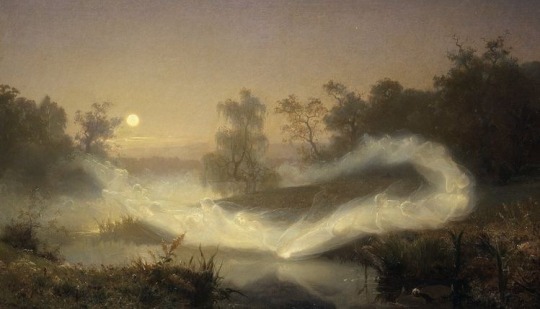
#alfar#elves#Freyr#norse mythology#norse paganism#norse myths#mythology#norse polytheism#polytheism#paganism#heathenry#ask#asks#spirits#spirit work#land spirits#elf
123 notes
·
View notes
